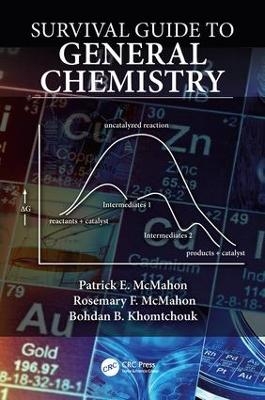
Survival Guide to General Chemistry
CRC Press (Verlag)
978-1-138-33362-8 (ISBN)
This work evolved over thirty combined years of teaching general chemistry to a variety of student demographics. The focus is not to recap or review the theoretical concepts well described in the available texts.Instead, the topics and descriptions in this book make available specific, detailed step-by-step methods and procedures for solving the major types of problems in general chemistry. Explanations, instructional process sequences, solved examples and completely solved practice problems are greatly expanded, containing significantly more detail than can usually be devoted to in a comprehensive text. Many chapters also provide alternative viewpoints as an aid to understanding.
Key Features:
The authors have included every major topic in the first semester of general chemistry and most major topics from the second semester. Each is written in a specific and detailed step-by-step process for problem solving, whether mathematical or conceptual
Each topic has greatly expanded examples and solved practice problems containing significantly more detail than found in comprehensive texts
Includes a chapter designed to eliminate confusion concerning acid/base reactions which often persists through working with acid/base equilibrium
Many chapters provide alternative viewpoints as an aid to understanding
This book addresses a very real need for a large number of incoming freshman in STEM fields
Dr Patrick E. McMahon has for the past twenty three years been teaching both general chemistry and organic chemistry at Benedictine University in Lisle, Illinois. Prior to that, he was a research scientist for Amoco Chemical Company at the Naperville, Illinois campus. McMahon has also taught at several institutions in the Chicago area, including Elmhurst College, Dominican University and Triton Community College. He is a member of the American Legion and served in the United States Army from 1970-1972. His main area of research interest is organic reaction catalysis. Awards that can be accredited to his name include the B.J. Babler award for outstanding contribution to under-graduate instruction at the University of Illinois, the Dean’s Award for Teaching Excellence at Benedictine University and first recipient of the Shining Star award given by the student senate for outstanding contribution to students at Benedictine University. Rosemary F. McMahon earned her B. S. with highest distinction in chemistry, M. S., and Ph. D. in organic chemistry at the University of Illinois. Her industrial career at Amoco Chemical and British Petroleum spanned chemicals process research and development, chemicals manufacturing, technical service, and customer support. She worked in oxidation chemistry, environmental catalyst chemistry, catalyst recovery processes, and manufacturing for product lines which included purified terephthalic acid, dimethyl 2,6-naphthalenedicarboxylate, and acrylonitrile. Her career later branched out to information technology as a patent and technical literature specialist supporting all technologies at BP worldwide. She is the co-author of four United States patents. Bohdan B. Khomtchouk, Ph.D. is an American Heart Association (AHA) Postdoctoral Fellow in the Department of Biology at Stanford University. Previously, he was an NIH/NIA Postdoctoral Research Scholar, National Institute on Aging of the National Institutes of Health (Stanford Training Program in Aging Research) at Stanford University and a National Defense Science & Engineering Graduate (NDSEG) Fellow at the University of Miami Miller School of Medicine.
Chapter 1 Unit Conversions And Density: An Introduction To Problem Solving Methods
Chapter 2 Atomic Particles, Isotopes, And Ions: An Initial Look At Atomic Structure
Chapter 3 Working With Atomic Mass And Nuclear Mass
Chapter 4 Procedures For Writing Formulas And Naming Compounds
Chapter 5 An Introduction To Moles And Molar Mass
Chapter 6 Procedures For Calculating Empirical And Moleculer Formulas
Chapter 7 Writing Chemical Equations
Chapter 8 Techniques For Performing Stoichiometric Calculations
Chapter 9 Precipitation And Acid/Base Aqueous Reactions: Concepts And Methods To Design Complete Balanced Equations
Chapter 10 Oxidation Numbers: A First Look At Redox Reactions
Chapter 11 Solution Concentration, Molarity, And Solution Stoichiometry
Chapter 12 Light, Matter, And Spectroscopy
Chapter 13 Atomic Orbitals And The Electronic Structure of the Atom
Chapter 14 Alternate Methods For Visualization And Constructing Lewis Structures Of Covalent Molecules
Chapter 15 Additional Techniques For Designing And Representing Structures Of Large Molecules
Chapter 16 Determining And Drawing Molecular Geometry And Polarity
Chapter 17 Summary Analysis Of Central Atom Bonding, Hybridization And Geometry
Chapter 18 Concepts Of Potential Energy, Enthalpy, And Bond Energy Calculations
Chapter 19 Thermochemistry Calculations: Heat Capacity And Enthalpy
Chapter 20 Working With Gas Laws
Chapter 21 Guideline For Analyzing Intermolecular Forces And Calculating Enthalpies
Chapter 22 Kinetics Part 1: Rate Laws, Rate Equations And An Introduction To Reaction Mechanisms
Chapter 23 General Techniques For Solving Equilibrium Problems
Chapter 24 Kinetics Part 2: Application Of Rate Laws And Rate Variables To Reaction Mechanisms
Chapter 25 Thermodynamics: Entropy And Free Energy
Chapter 26 Acid/Base Equilibrium, pH, And Buffers
| Erscheinungsdatum | 28.02.2019 |
|---|---|
| Zusatzinfo | 50 Tables, black and white; 1000 Illustrations, black and white |
| Verlagsort | London |
| Sprache | englisch |
| Maße | 178 x 254 mm |
| Gewicht | 902 g |
| Themenwelt | Medizin / Pharmazie |
| Naturwissenschaften ► Biologie ► Biochemie | |
| Naturwissenschaften ► Chemie ► Organische Chemie | |
| Sozialwissenschaften ► Pädagogik ► Allgemeines / Lexika | |
| ISBN-10 | 1-138-33362-X / 113833362X |
| ISBN-13 | 978-1-138-33362-8 / 9781138333628 |
| Zustand | Neuware |
| Haben Sie eine Frage zum Produkt? |
aus dem Bereich


